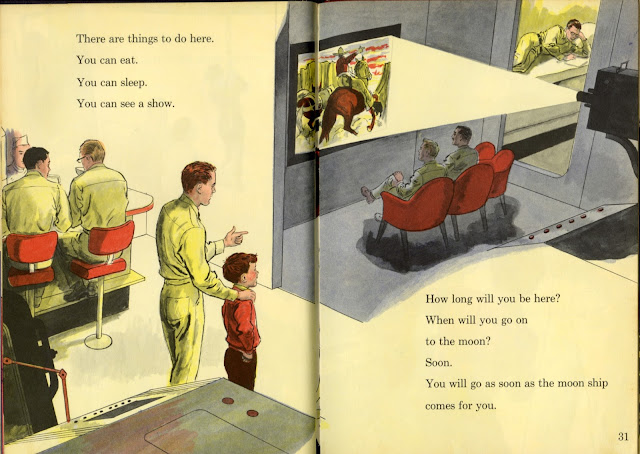This is my 500th post! So I am going back for a deep look at the first book I ever posted about,
my personal favorite children's space book.
It concerns an imaginary trip to the Moon taken by a young boy and his adult friend. The rocket, and space station, are very much Von Braun style, while the Moon landing craft and Moon base are more British Interplanetary Society designs. The cover states that for accuracy the manuscript was submitted to the Office of the Director of Research and Development of the United States Air Force.
http://dreamsofspace.blogspot.com/2009/02/you-will-go-to-moon-1959.html
This is meant to be a sort of ultimate post for this book so I can bring you EVERYTHING I can about it. So first has to be why the cover above is different from the cover below.
The first cover is the original paper cover as issued but the second cover is that of the "I can read it all by myself" Beginner Book series. This was a series of books by mail that parents could order. As you can see they were cloth covers (for reduction in cost). They put hundreds of thousand of copies into the hands of children across America in the early 1960s.
These were the first Beginner Books as supervised by Dr. Suess. He had started with "The Cat in the Hat" and had been encouraged to invite other authors to write these simple books under the Beginner Books imprint.
Freeman, Mae and Freeman, Ira. Illustrated by Patterson, Robert. You Will Go to the Moon. New York: Beginner Books. (54 p.) 24 cm. Illustrated Boards, DJ. 1959. "I can read it all by myself Beginner Books " (195/195). Also 1971 edition.
One of the most attractive things about the book is the vibrant colors used. The blues, yellows and oranges are used to make each page an "eyewitness" painting. The book is a true picture book with a large illustration on every page.
One of my favorite rocket launch paintings I have ever seen. Arranged with a diagonal perspective the rocket is poised to leave the page.
A beautiful view of the earth from space and of rocket staging. With the very simple text the child (me!) could read the story of just follow the action until I needed words to explain what was happening.
 |
| YOU ARE A SPACE MAN NOW |
The Von Braun space station is almost iconistic in these illustrations. I like the framing in the enlarged window. You also start to notice how the artist changes perspective at will so you can see all that is happening. Also notice how the author made some words red to increase the impact.
The illustrations come closer and closer to the Collier's of 1952-54. The military uniforms, the space station as a military outpost with a canteen and films. And the introduction of the "Space Bug" as the next tool to go to the Moon.
So onward to next week when we will go to the Moon and explore this book further. See ya then....


















































